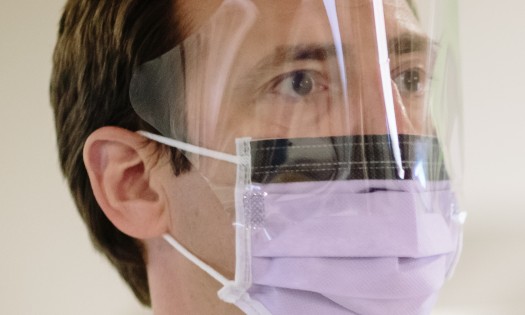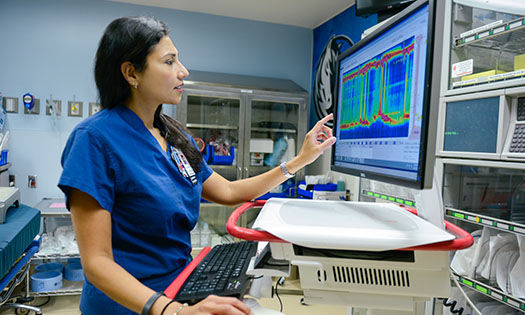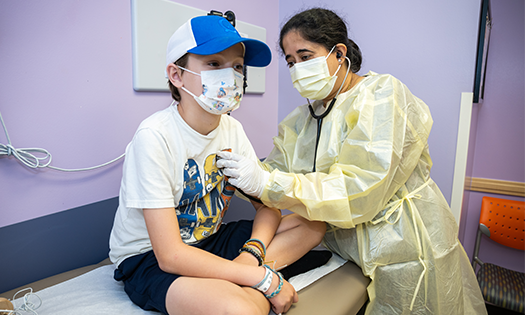By the time 15-month-old Vance was referred to Children’s Health℠, Children’s Medical Center Dallas, his family was afraid they were out of options to relieve their son’s chronic vomiting. Vance had thrown up multiple times a day since birth, often vomiting undigested food up to 24 hours after ingestion. Consequently, he was struggling to gain weight and couldn’t transition to solid foods.
A barrage of diagnostic tests performed prior to referral — including upper endoscopy, colonoscopy, x-ray and upper GI studies — yielded no clear answers. And pharmacological intervention with medications like ondansetron, cyproheptadine and erythromycin were ineffective.
Fortunately, the problem was familiar to Rinarani Sanghavi, M.D., Director of the Neurogastroenterology and GI Motility program at Children’s Health and Associate Professor at UT Southwestern. Dr. Sanghavi diagnosed Vance with gastroparesis. Then she and Vance’s mother decided on an innovative treatment: injecting Botox into Vance’s pyloric sphincter. The goal was to relax the pylorus and make it easier for food to exit the stomach.
“This approach had been used in adults, but is uncommon in children,” Dr. Sanghavi says. “It was very successful — Vance was able to eat without vomiting for the first time, and follow-up treatments stopped his vomiting for more than four years.”
A Complicated Diagnosis
As a tertiary motility referral center, Children’s Health sees more pediatric GI patients than almost any other center in the region. This experience helps Dr. Sanghavi evaluate and diagnose complex patients like Vance, who has a history of intrauterine growth restriction and a mild Chiari malformation.
A scan performed when Vance came to Children’s Health indicated that gastric emptying was occurring normally, but Dr. Sanghavi suspected the results were distorted.
“Target norms for how quickly food leaves the stomach have been established only for solid foods, and Vance wasn’t on solids yet and was not able to complete the meal,” she says.
Vance’s clinical symptoms – his persistent vomiting of mostly undigested food up to 24 hours after consumption – led her to the gastroparesis diagnosis. Since previous medications were ineffective, the next logical treatment option was Metoclopramide. However, the medication has causes dystonia in a small percentage of patients and Vance’s mother was uncomfortable with that risk.
“We decided to try the Botox approach, with hope it would improve Vance’s digestion and spare him from undergoing a pyloromyotomy,” Dr. Sanghavi says.
A Painless Alternative to Major Surgery
The Botox injection into the pylorus is performed endoscopically.
“It takes 10 minutes for the procedure, and the child goes home an hour or two later, without feeling any discomfort,” Dr. Sanghavi says.
She gave Vance an injection of 100 units of Botox in July 2014, followed by another injection in December of that year. The results were remarkable: Vance’s vomiting subsided for nearly five years.
The Children’s Health team delivered another Botox injection in 2019.
Over time, there is a risk that the injections could cause Vance to develop scar tissue that recreates the original problem of a stiff stomach exit.
“We may need to eventually consider surgery, but Vance did so well for four years that we’re hoping that the latest injection will keep him going for another four to five years,” Dr. Sanghavi says. “Then, if he does need surgery, he’ll have a better opportunity for a good outcome.”
Going the Extra Mile With Payors
When Vance was getting set for his latest injection, the process hit a barrier when his family’s insurance company declined coverage. Dr. Sanghavi and her team made multiple calls, spent hours on the phone, and sent numerous research articles to convince the insurer that the treatment was legitimate.
“Vance’s mom is a high school teacher, and she started crying with relief in her classroom when she got the news the procedure was approved,” Dr. Sanghavi says.
Gastric Pacemakers and Other Innovative Therapies
Vance is now an active 6-year-old who enjoys gymnastics, dance and school. He has a great sense of humor and loves spending time with his five big brothers.
“I can drive my car and not be afraid that he will vomit and choke,” his mom says. “I even had to make the waist of his pants a little bigger!”
The Botox approach is just one example of how the Children’s Health GI team is constantly finding innovative solutions for our patients. For example, we’re among a small handful of centers offering the gastric pacemaker for children. Dr. Sanghavi has successfully implanted the device in two pediatric patients.
“When you have a patient come in like Vance, who was so miserable, you’re really motivated to explore all possible options,” says Dr. Sanghavi. “It’s such a privilege to watch these patients grow and thrive.”
Learn more about the innovative work being done by the thought leaders in our GI department


